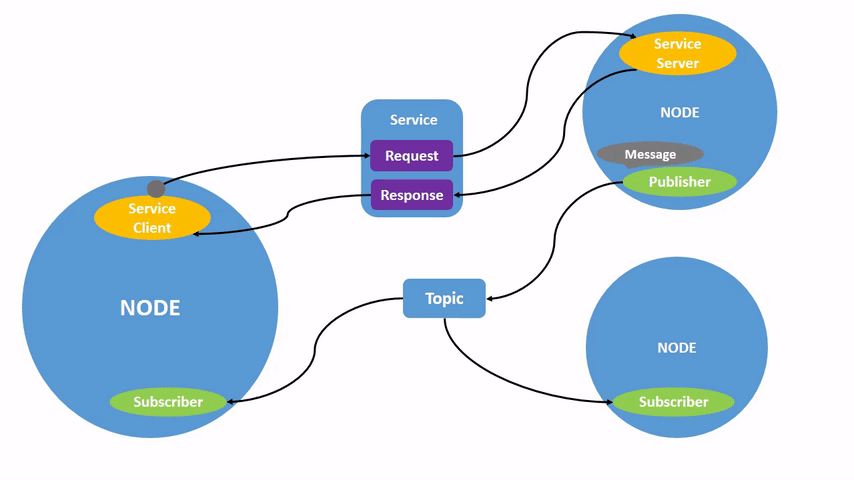每日一问:我学PCL了吗?领导给批显卡了吗?
:没有
为什么要订阅数组型消息
比如在这个场景下:YOLO在场景中检测到多个目标,并通过其他算法得到了目标的ID,class,位置,速度等信息。这些信息会作为避障或局部路径规划的依据。一台自动驾驶汽车或机器人上的其他算法模块也可能需要这些信息,这种时候会用ros来进行通讯。
假设这是需要订阅的msg,其中包含了int64数组和float64数组,这些数组都是不定长数组。
int64[] objID
int64[] objClass
float64[] xPos
float64[] yPos
float64[] dist
float64[] xSpeed
float64[] ySpeed
int64 objNum
Publisher和Subscriber
Publisher
//
// Created by funnywii on 2023/3/10.
// The main function for testing other functions.
//
#include <iostream>
#include "src/MyHeaders.h"
#include <opencv2/opencv.hpp>
#include "src/YoloV5.h"
#include "src/CppLearning.h"
#include <ros/ros.h>
#include <std_msgs/String.h>
#include "funnywiitest/funnywii_msg.h"
#include<cstdlib> // rand()和srand() 包含在这个库中
int main(int argc, char **argv)
{
ros::init(argc, argv, "funnywiipublisher");
ros::NodeHandle n;
ros::Publisher funny_pub = n.advertise<funnywiitest::funnywii_msg>("test_topic",100);
ros::Rate loop_rate(1);
int loopLimt = 10;
std::vector<int64_t> objID;
std::vector<int64_t> objClass;
std::vector<double> xPos;
std::vector<double> yPos;
while (ros::ok())
{
funnywiitest::funnywii_msg msg;
for (int i = 0; i < loopLimt; i++)
{
objID.push_back(int(rand() / 1e6));
std::cout << objID[i] <<std::endl;
objClass.push_back(int(rand() / 1e6));
xPos.push_back(float(rand() / 1e6));
std::cout << xPos[i] <<std::endl;
yPos.push_back(float(rand() / 1e6));
}
msg.objID = objID;
msg.objClass = objClass;
msg.xPos = xPos;
msg.yPos = yPos;
// 发布消息 把这个信息广播给任何已连接的节点
funny_pub.publish(msg);
ros::spinOnce();
// 按照循环频率延时
loop_rate.sleep();
}
cout << "Test Done" << endl;
}
Subscriber
#include <ros/ros.h>
#include "funnywiitest/funnywii_msg.h"
#include <std_msgs/String.h>
// 接收到订阅的消息后,会进入消息回调函数
void callback(const funnywiitest::funnywii_msg::ConstPtr & msg)
{
// 将接收到的消息打印出来 !注意占位符
for (int i = 0; i < msg->objID.size();i++){
ROS_INFO("------------------ msg ---------------------");
ROS_INFO("The objID [%ld]",msg->objID[i]);
ROS_INFO("The objID [%ld]",msg->objClass[i]);
ROS_INFO("The objID [%lf]",msg->xPos[i]);
ROS_INFO("The objID [%lf]",msg->yPos[i]);
}
}
int main(int argc, char **argv)
{
// 初始化ROS节点
ros::init(argc, argv, "funnywiisubscriber");
// 创建节点句柄
ros::NodeHandle n;
// 创建一个Subscriber,订阅名为my_topic的消息,注册回调函数 callback
ros::Subscriber funny_sub = n.subscribe<funnywiitest::funnywii_msg>("test_topic", 100, callback);
// 循环等待回调函数
ros::spin();
return 0;
}
运行 rosrun funnywiitest funnywiisubscriber之后,可以看到运行结果:
[ INFO] [1683534532.867650458]: ------------------ msg ---------------------
[ INFO] [1683534532.867660196]: The objID [2106]
[ INFO] [1683534532.867669170]: The objID [1780]
[ INFO] [1683534532.867678599]: The objID [976.112915]
[ INFO] [1683534532.867688689]: The objID [1443.911743]
[ INFO] [1683534532.867697808]: ------------------ msg ---------------------
[ INFO] [1683534532.867707752]: The objID [2005]
[ INFO] [1683534532.867716578]: The objID [1286]
[ INFO] [1683534532.867726476]: The objID [1798.004028]
[ INFO] [1683534532.867736020]: The objID [156.275818]
[ INFO] [1683534532.867744898]: ------------------ msg ---------------------
[ INFO] [1683534532.867753617]: The objID [1494]
[ INFO] [1683534532.867762170]: The objID [549]
[ INFO] [1683534532.867771531]: The objID [580.149780]
[ INFO] [1683534532.867781842]: The objID [2040.718872]
之所以用C++标准库中的 vector.pushback进去,是因为在 .msg中定义的数组为不定长数组,如果直接用 for循环依次向数组里写值,则会报错,因此使用上述方式依次向空数组尾部添加新的value。
C++ 占位符
同时,在 ROS_INFO("The objID [%ld]",msg->objID[i]);这行代码中出现了占位符,一定要注意占位符的正确使用,比如 int16和 int32的占位符是不同的,如果混淆使用,即使编译能通过,程序运行时也会报错(如segmentation fault)。
详细占位符信息可以参考如下表格:
| 符号属性 | 长度 | 基本型 | 位数 | 取值范围 | 输入符举例 | 输出符举例 |
|---|---|---|---|---|---|---|
| -- | -- | char | 8 | -2^7 ~ 2^7-1 | %c | %c、%d、%u |
| signed | -- | char | 8 | -2^7 ~ 2^7-1 | %c | %c、%d、%u |
| unsigned | -- | char | 8 | 0 ~ 2^8-1 | %c | %c、%d、%u |
| [signed] | short | [int] | 16 | -2^15 ~ 2^15-1 | %hd | %hd |
| unsigned | short | [int] | 16 | 0 ~ 2^16-1 | %hu | %hu 、%ho、%hx |
| [signed] | -- | int | 32 | -2^31 ~ 2^31-1 | %d | %d |
| unsigned | -- | [int] | 32 | 0 ~ 2^32-1 | %u | %u 、%o、%x |
| [signed] | long | [int] | 32 | -2^31 ~ 2^31-1 | %ld | %ld |
| unsigned | long | [int] | 32 | 0 ~ 2^32-1 | %lu | %lu 、%lo、%lx |
| [signed] | long long | [int] | 64 | -2^63 ~ 2^63-1 | %I64d | %I64d |
| unsigned | long long | [int] | 64 | 0 ~ 2^64-1 | %I64u | %I64u、%I64o、%I64x |
| -- | -- | float | 32 | +/- 3.40282e+038 | %f、%e、%g | %f、%e、%g |
| -- | -- | double | 64 | +/- 1.79769e+308 | %lf 、%le、%lg | %f、%e、%g |
| -- | long | double | 96 | +/- 1.79769e+308 | %Lf、%Le、%Lg | %Lf 、%Le、%Lg |

